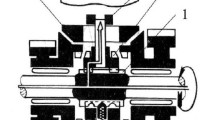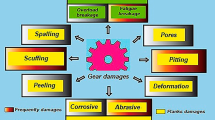The static strength theory became the basis for the design of the gear box in tracked vehicles. The dynamic characteristics of the gear box under different working conditions cannot be evaluated accurately, the reliability and fatigue life are difficult to study due to the limit dons of conventional tests and experimental techniques, the service life of the gear box was much shorter than the design one, thus the reliability of tracked vehicles was also affected deeply. The dynamic load of each part of the gear box under different working conditions was evaluated by setting up an MSC.ADAMS test program. The actual load applied to the fatigue life prediction system of the gear box provides the fatigue lives of box-related parts. The fatigue life prediction method of the gear box was verified as to its feasibility with running simulation tests.















Similar content being viewed by others
References
X. J. Du, C. Z. Jia, and J. Wu, “Research on fatigue life prediction of planetary cage in caterpillar base on running simulation test,” Appl. Mech. Mater., 226–228, 862–866 (2012).
Z. W. Dong, J. Wu, and X. J. Du, “Research on fatigue life prediction of gear box in caterpillar based on running simulation test,” Appl. Mech. Mater., 226–228, 627–631 (2012).
X. J. Du, C. Z. Jia, and Z. W. Dong, “Simulation and prediction of fatigue life of planetary gear of tracked vehicle,” J. Vibr. Shock, 33, No. 13, 106–110 (2014).
C. Z. Jia, X. J. Du, and G. S. Liu, “Simulation analysis and improvement of dynamic characteristics of gun impact buffer device,” J. Mech. Eng., 48, No. 19, 156–163 (2012).
C. Z. Jia, X. J. Du, Z. W. Dong, and Y. H. Zhang. “Study on fatigue life prediction of wheel rim reducer based on driving simulation test,” J. Mech. Strength, 36, No. 3, 449–454 (2014).
C. Z. Jia, Z. J. Yin, and W. X. Xue, MD ADAMS Virtual Prototype from Entry to Master, Mechanical Industry Press, Beijing (2010), pp. 10–50.
X. J. Du, C. Z. Jia, Z. W. Dong, and Q. X. Zhang, “Application of interface-based co-simulation in dynamic optimization design,” J. Mech. Eng., 44, No. 8, 123–131 (2008).
H. D. Shen, Z. Q. Li, L. L. Qi, and L. Qiao, “A method for gear fatigue life prediction considering the internal flow field of the gear pump,” Mech. Syst. Signal Pr., 99, 921–929 (2018).
F. Zhao, Z. Tian, E. Bechhoefer, and Y. Zeng, “An integrated prognostics method under time-varying operating conditions,” IEEE Trans. Reliab., 64, No. 2, 673–686 (2015).
Q. B. Cui, A Self-Propelled Artillery Box Dynamics Simulation and Life Prediction, Ordnance Engineering College, Shijiazhuang (2005).
B. Y. Liao, X. M. Zhou, and Z. H. Yin, Modern Dynamics of Machinery and Its Application in Engineering, China Machine Press, Beijing (2004).
G. L. Xiong, B. Guo, and X. B. Chen, Collaborative Simualation & Virtual Propotyping, Tsinghua University Press (2004).
X. B. Chen, G. L. Xiong, B. Guo, et al., “Research on co-simulation running based on HLA,” J. Syst. Simul., 15, No. 12, 1537–1542 (2003).
X. J. Du, Z. W. Dong, X. G. Wang, and Q. X. Zhang, “Research on collaborative simulation based on interfaces used in weapon system,” J. Syst. Simul., 18, No. 5, 1371–1375 (2006).
X. J. Du, Research on Dynamic Simulation and Life Prediction of Self-Propelled Gun’s Drive System, Ordance Engineering College, China (2006), pp. 100–104.
Committee of Planetary Transmission of Involute Gear’s Design and Manufacturing, China Machine Press, Beijing (2002).
D. L. Wu, Research on Road Simulation of Self-Propelled Gun, Ordance Engineering College, China (2004), pp. 60–75.
Acknowledgments
This study was sponsored by Hebei Province Science and Technology Projects (16211806D and 18214302D), Hebei Education Department (ZD2016084). Project of Hebei Province Higher Educational Science and Technology Research, China (ZD2017044), and Open Project of Industrial Energy-Saving and Power Quality Control of Anhui Province of China (KFKT201504).
Author information
Authors and Affiliations
Corresponding author
Additional information
Translated from Problemy Prochnosti, No. 4, pp. 90 – 99, July – August, 2019.
Rights and permissions
About this article
Cite this article
Du, X.J., Zhang, S.R. & Zhang, Y.H. Fatigue Life Prediction of the Gear Box in Tracked Vehicles Based on Running Simulation Tests. Strength Mater 51, 578–586 (2019). https://doi.org/10.1007/s11223-019-00103-7
Received:
Published:
Issue Date:
DOI: https://doi.org/10.1007/s11223-019-00103-7




